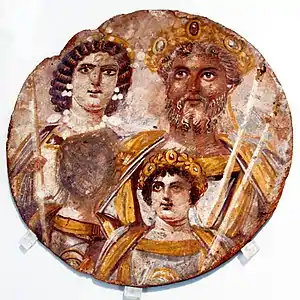Severan Tondo
The Severan Tondo or Berlin Tondo from circa 200 AD, is one of the few preserved examples of panel painting from Classical Antiquity, depicting the first two generations of the imperial Severan dynasty, whose members ruled the Roman Empire in the late 2nd and early 3rd centuries. It depicts the Roman emperor Septimius Severus (r. 193–211) with his family: his wife, the augusta Julia Domna, and their two sons and co-augusti Caracalla (r. 198–217) and Geta (r. 209–211). The face of one of the two brothers has been deliberately erased, very likely as part of damnatio memoriae.[1]
| The Severan Tondo | |
|---|---|
 | |
| Year | 2nd century AD |
| Dimensions | 30.5 cm diameter (12.0 in) |
| Location | Antikensammlung, Altes Museum, Berlin |
On the viewer's right is Septimius Severus, and to the left Julia Domna. In front of them are the boys Caracalla and Geta, probably the figure with the erased face on the viewer's left and slightly to the rear of the other boy. All wear jewelled gold wreaths and imperial insignia, some details of which have been lost. Having emerged from the antiquities trade, the wooden tondo's provenance is unknown before entering the Antikensammlung Berlin (inventory number 31329) in the 20th century. It is now in the Altes Museum.
Description
The work is a tempera or egg-based painting on a circular wooden panel or tondo with a diameter of 30.5 centimetres (12.0 in). It depicts the Imperial family wearing sumptuous ceremonial garments. Septimius Severus and his sons are also holding sceptres and wearing gold wreaths decorated with precious stones. This image of a grey-haired Severus, with his wife and young children, emphasises the dynastic ambitions of the new emperor after the turbulent Year of the Five Emperors. The darker skin tone of Severus reflects his Libyan origins. Julia Domna has her distinctive hairstyle, crimped into parallel locks, possibly a style from her home in Syria, and perhaps a wig.
One son's face has been obliterated in a deliberate act of iconoclasm, and the vacant space smeared with excrement. Most scholars believe it is Geta whose face has been removed, probably after his murder by Caracalla's Praetorian Guard and the ensuing damnatio memoriae. However, it is also possible that Geta (as the younger son) is the smaller boy, and it is Caracalla's face which was eradicated, perhaps as a compensatory retaliation for Caracalla's mass execution of young Alexandrian men in the year 215.[2]
The tondo was probably created in a square or rectangular shape, and later cut into a circle. The loss of some of the original painting is most apparent with the sceptres that the males are holding: the upper parts, once adorned with imperial symbols, are now missing. It seems likely that the panel was cut down in modern times to improve its saleability on the art market.[3]
Interpretation
The image is probably an example of imperial portraits that were mass-produced to be displayed in offices and public buildings throughout the Roman Empire; as part of Roman legal procedure, some documents had to be signed in front of an image of the emperor, which gave them the same status as if signed in his actual presence.[4] With each change of emperor, the portrait would have been discarded or replaced. Since wood is an organic material and does not normally survive, the Berlin Tondo remains, so far, the only surviving specimen of this type of painting.[5]
Provenance
The tondo appears to be of Egyptian origin, using similar materials and style to the Fayum mummy portraits. It may have been painted to celebrate the visit of Septimius Severus to Egypt in 199 CE, following his military victories against the Parthian Empire the previous year, and before his campaigns in north Africa in 203. Caracalla, born in 188, is depicted as a youth, indicating a date before about 205.
The history of the painting after its creation is not known until the Antikensammlung Berlin acquired it in 1932 from an art dealer in Paris. It is in the Altes Museum, one of the Berlin State Museums (Staatliche Museen zu Berlin).[6]
.jpg.webp) Another image of the tondo, better for detail
Another image of the tondo, better for detail Another example of dynastic portraits on an aureus of Septimius Severus, minted in 202. The reverse feature the portraits of Geta (right), Julia Domna (centre), and Caracalla (left).[7]
Another example of dynastic portraits on an aureus of Septimius Severus, minted in 202. The reverse feature the portraits of Geta (right), Julia Domna (centre), and Caracalla (left).[7]
See also
References
- Altes Museum
- Dieter Metzler, "Bilderstuerme und Bilderfeindlichkeit in der Antike," in Bildersturm, ed. Martin Warnke (Munich, 1973), pp. 17-18
- Vincent Rondot: Derniers visages des dieux d'Égypte, Paris 2013 ISBN 978-2840508571, p. 33
- Quenot, Michael (1991). The Icon: Window on the Kingdom. St Vladimir's Seminary Press. p. 16. ISBN 0-88141-098-5.
- Hiesinger, Ulrich W. (1969). "Julia Domna: Two Portraits in Bronze". American Journal of Archaeology. Archaeological Institute of America. 73 (1): 39–44. doi:10.2307/503372. ISSN 1939-828X. JSTOR 503372 – via JSTOR.
Some idea of the impression such ornaments would have produced may be derived from the painted tondo from Egypt with shows Julia Domna with pearl pendent earrings and a jeweled diadem and necklace.
- Altes Museum
- Harold Mattingly, Edward A. Sydenham, The Roman Imperial Coinage, vol. IV, part I, Pertinax to Geta, London, Spink & Son, 1936, p. 115.
Bibliography
- Antikenmuseum Berlin; Wolf-Dieter Heilmeyer (1988). Die ausgestellten Werke (in German). Berlin: Staatliche Museen Preußischer Kulturbesitz. p. 373.
External links
- Severan Tondo, Altes Museum, Staatlichen Museen zu Berlin
- Caesars' Wives: Sex, Power, and Politics in the Roman Empire, Annelise Freisenbruch], p.186
- Mutilation and transformation : damnatio memoriae and Roman imperial portraiture, Volume 10 of Monumenta Graeca et Romana', ISBN 9004135774, p.181-182
- Imperial Rome and Christian Triumph: The Art of the Roman Empire AD 100-450, Jaś Elsner, p.55-56